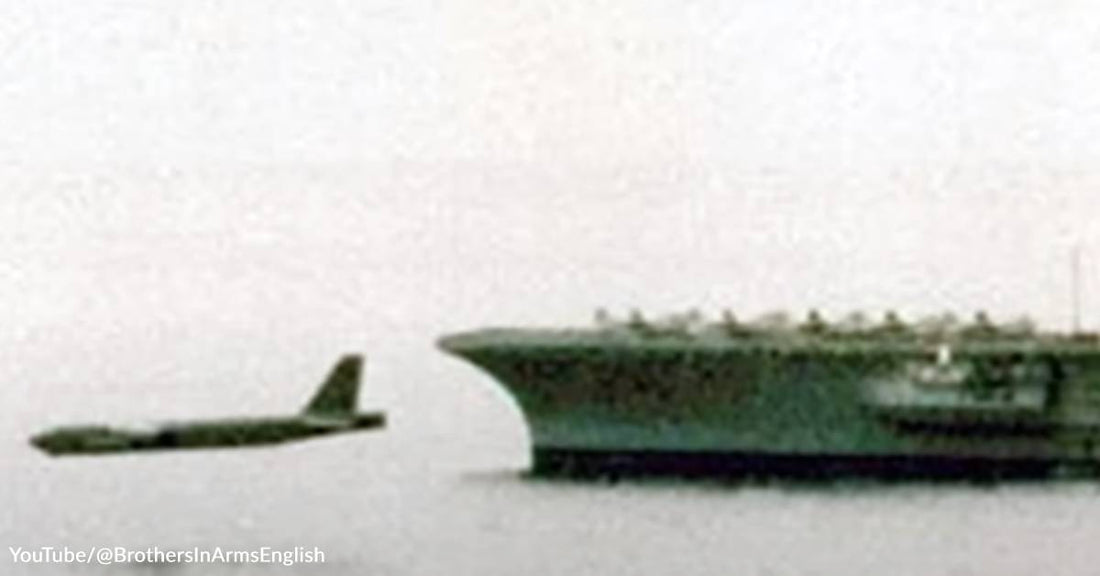Seeing Is Believing: The Day We Flew Too Low to Be Believed
Dan Doyle
The Russians back in the middle of the Cold War had made several attempts to send some of their aircraft over U.S. aircraft carriers to photograph them and to learn what they could about the big U.S. warships. Well, that was not going to go either unnoticed or without some kind of response.
The decision was made by the Navy and the Air Force to try an experiment with our long-range bombers, specifically the B-52s, to simulate the Russian efforts to spy on and photograph our carriers. Now, when you think of a B-52, words like "nimble" or "stealthy" do not spring to mind. They are not, after all, A-10s or F-22s. They are not built for the kind of things that fighter jets are built for, by any stretch of the imagination. They are big, heavy behemoths, built to fly high and to carry huge bomb loads over long ranges.
 Photo: YouTube/@BrothersInArmsEnglish
Photo: YouTube/@BrothersInArmsEnglishAs I have written before, I have experienced B-52s up close and personal in two different ways. The first was at Kadena Air Force Base on Okinawa on my way to Vietnam in January of 1968. Our Marine transient barracks were near the end of the runway that the B-52s took off from and landed on going to and returning from missions over Vietnam. When they took off or landed over our barracks, their massive size would literally block the sun as they passed over, and the building would actually vibrate from the sound of their massive engines as they passed over. They were intimidating, to say the least.
The second experience I had with them was at the 77-day siege at Khe Sanh. Throughout the siege, flights of three B-52s at a time would fly near Khe Sanh, dropping their loads of hundreds of heavy bombs on top of the NVA troops in the hills and areas around Khe Sanh in an effort to keep them off of us. They flew at some 30,000 ft., so we never saw them or heard them or even knew of their presence until we saw the long lines of massive explosions as their bombs struck the earth. In the beginning, they were dropping those bombs no closer than 3 miles from the base perimeters. Toward the end of the siege, they were dropping them as close as a mile from the wires. We could feel the concussive sound waves from those explosions because they were so close.
 Photo: YouTube/@BrothersInArmsEnglish
Photo: YouTube/@BrothersInArmsEnglishBecause of these memories and the sheer size of B-52s, I was really surprised when I ran across this video and the story behind it. In 1989, the Navy and Air Force conducted an exercise to simulate how Russians were trying to photograph our carriers. The exercise involved a B-52 bomber playing the role of the Russians attempting to scout the aircraft carrier. The carrier's job was to see how they could spot the B-52s with radar, etc., in time to send up fighter jet interceptors.
Well, here's the fun part; something that the Navy never expected. You see, the Air Force had been practicing low-level flying for years to be able to fly under the Russian radar systems. When the exercise was underway, the B-52 pilot contacted the aircraft carrier and asked if he could do a fly-by. The Navy responded to the B-52 pilot, saying something like, "We can't spot you anywhere," to which the B-52 pilot responded dryly, "You should look down." When the B-52 passed by the aricraft carrier, it was so low that it was below the flight deck of the carrier. Talk about mind-blowing!
 Photo: YouTube/@BrothersInArmsEnglish
Photo: YouTube/@BrothersInArmsEnglishThe B-52 pilots asked if they could come around again, to which all the sailors aboard replied with an enthusiastic, "YES!" Who wouldn't have said yes? Who would have thought that that huge plane could be flown so aggressively, so nimbly, or so stealthily? Of course, with satellites, etc., such maneuvers are no longer necessary, but that skill is still possible whenever it might be needed.
This short film is a kick to watch. One wishes one could have been on that aircraft carrier when that B-52 flew by beneath their own flight deck. That must have been a site to behold.
https://www.youtube.com/shorts/ivtfy2DlpJ4


